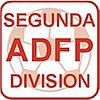Segunda Division Peruana
 |
|
| Country | Peru |
|---|---|
| Founded | 1936 |
| Number of teams | 12 |
| Level on pyramid | 2 |
| Promotion to | Primera División |
| Relegation to | Copa Perú |
| Current champions |
Cantolao (2016) |
| TV partners | CMD |
| Website | www.adfp-sd.com |
|
|
|
The Segunda División Peruana (Second Division) of Peru is the second-highest division in the Peruvian football league system. It is a professional division and was declared a promotional division by the Peruvian Football Federation (FPF). After years of changing numbers of clubs, as of 2014 the league includes 16 clubs. It is currently organized by the Asociación Deportiva de Futbol Profesional.
The format of the Second Division has changed over the years. For decades after it was first formed in 1936, only clubs from the Department of Lima participated in the annual tournament. The winner was promoted to the Primera Division Peruana (First Division), the professional league.
As of 2010, the winner of the tournament will be promoted to the First Division, while the last team will be relegated from the tournament and will play in the 2011 edition of the Copa Perú. Their places will be taken by the two relegated clubs of the First Division, and the team that finishes second place in the 2010 Copa Perú.
The Peruvian Segunda División is sponsored by Movistar TV, hence the name Torneo de Ascenso. They have had exclusive broadcasting rights.
The Segunda División has received numerous criticisms, chiefly due to the lack of stability in the process of competition and promotion, and the lack of professionalism. Most critics accuse the football federation president, Manuel Burga, as the cause of the problems and an unpopular figure recently in Peruvian football.
The Segunda División has several times changed the number of teams that operate in the league. Over the course of 74 years, the Segunda has had as few as four teams and as many as 16. The early Segunda División were played with an average number of teams ranging from 4 to 10. Prior to the current 12-club Segunda División, during the 2000s, the team count continued to fluctuate between 10, 12, 14, 16 and even a surprising 13. For example, 12 teams competed in 2009, 10 competed in 2008, 11 competed in 2007, and 12 teams competed from 2004-2006. In 2001 and 2002, the Segunda División played with a record 16 teams.
Several stadiums used in the second division have artificial grass installed for the so-called massification of sport. Most stadiums in Peru are owned by the IPD (Instituto Peruano del Deporte), which is the state group responsible for supporting the use of artificial turf. This has been severely criticized by top division teams and the media. At first, these artificial turfs were installed for the 2005 FIFA U-17 World Cup; however, more artificial turf was installed in other stadiums after the U-17 World Cup concluded. These turfs are criticized for having a negative influence on the game and for the injuries which they cause to players.
...
Wikipedia
